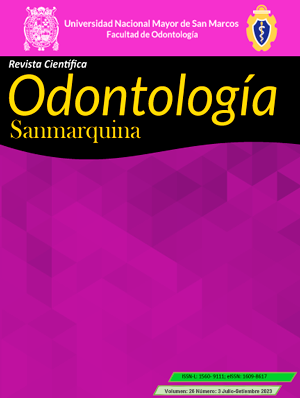Analysis of the distribution of microhardness, mineral, and organic content of human, bovine, and ovine teeth
DOI:
https://doi.org/10.15381/os.v26i3.24730Keywords:
Spectrum Analysis, Raman, Hardness, Collagen Type I, Collagen Type III, Models, AnimalAbstract
Objetive. Human teeth have been commonly used for in vitro and in situ studies. Currently, other animals’ teeth have been purposed for dental research to overcome human teeth’ problematic availability. This study aimed to investigate the enamel and dentin from human, bovine, and ovine teeth concerning the microhardness, organic, and inorganic contents via micro-Raman spectroscopy. Methods. Human, bovine, and ovine teeth were divided according to their type and age into seven groups: Ovine; Bovine-12 months; Bovine-24 months; Bovine-36 months; Bovine-48 months; Bovine-+60 months; Human (control). The enamel’s microhardness (superficial and deep) and dentin (superficial, middle, and deep) were analyzed. The calcium/phosphate ratio and amide contents were determined by micro-Raman spectroscopy. Results. Overall, the microhardness of human enamel was superior to the other species. Dentin’s microhardness was similar among groups. Ovine group showed lower values of calcium/phosphate ratio than human. Amide content was similar between bovine and human. The microhardness and calcium/phosphate ratio of enamel and dentin, respectively, decreased as the age of bovine teeth increased. Conclusions. Researchers must be aware and take into consideration the differences of ovine and bovine enamel compared to human enamel. Other alternatives that are more similar to the microhardness of human enamel should be sought. Bovine teeth of 12 and 24 months are suitable substitutes for dentin of human teeth. Researchers must also be aware of the age of the animals and specify it in the studies.
Downloads
Downloads
Published
Issue
Section
License
Copyright (c) 2023 Felipe Weidenbach Degrazia, Jaqueline Wermeier Rippel, Isadora Martini Garcia, Bruna Genari, Susana Maria Werner Samuel, Fabrício Mezzomo Collares

This work is licensed under a Creative Commons Attribution 4.0 International License.
AUTHORS RETAIN THEIR RIGHTS:
a. Authors retain their trade mark rights and patent, and also on any process or procedure described in the article.
b. Authors retain their right to share, copy, distribute, perform and publicly communicate their article (eg, to place their article in an institutional repository or publish it in a book), with an acknowledgment of its initial publication in the Odontología Sanmarquina.
c. Authors retain theirs right to make a subsequent publication of their work, to use the article or any part thereof (eg a compilation of his papers, lecture notes, thesis, or a book), always indicating the source of publication (the originator of the work, journal, volume, number and date).




















